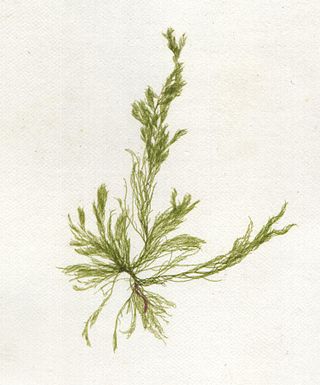
Cladophorales are an order of green algae, in the class Ulvophyceae.

Bembicosoma is a genus of synziphosurine, a paraphyletic group of fossil chelicerate arthropods. Bembicosoma was regarded as part of the clade Planaterga. Fossils of the single and type species, B. pomphicus, have been discovered in deposits of the Silurian period in the Pentland Hills, Scotland. Bembicosoma had been tentatively assigned as an eurypterid before its synziphosurine affinities revealed.
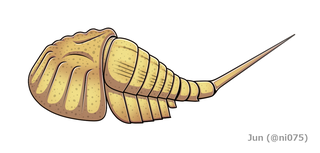
Bunodes is a genus of synziphosurine, a paraphyletic group of fossil chelicerate arthropods. Bunodes was regarded as part of the clade Planaterga. Fossils of the single and type species, B. lunula, have been discovered in deposits of the Silurian period in Ludlow, England. Bunodes is the type genus of the family Bunodidae, the other genera of the same family being Limuloides.

Cyamocephalus is a genus of synziphosurine, a paraphyletic group of fossil chelicerate arthropods. Cyamocephalus was regarded as part of the clade Planaterga. Fossils of the single and type species, C. loganensis, have been discovered in deposits of the Silurian-aged Patrick Burn Formation in Lesmahagow, Scotland. Cyamocephalus is one of the two members of the family Pseudoniscidae, the other being Pseudoniscus. Cyamocephalus differ from Pseudoniscus by the fused tergites of 6th and 7th opisthosomal segments.

Legrandella is a genus of synziphosurine, a paraphyletic group of fossil chelicerate arthropods. Legrandella was regarded as part of the clade Prosomapoda. Fossils of the single and type species, L. lombardii, have been discovered in deposits of the Devonian period in Cochabamba, Bolivia.

Limuloides is a genus of synziphosurine, a paraphyletic group of fossil chelicerate arthropods. Limuloides was regarded as part of the clade Planaterga. Fossils of the genus have been discovered in deposits of the Silurian period in the United Kingdom and potentially in the United States. Limuloides is one of the two genera of the family Bunodidae, the other being the type genus Bunodes. Limuloides is characterized by a carapace with radiated ridges and serrated lateral regions, and an opisthosoma with rows of nodes. Limuloides was once though to have lateral compound eyes on its carapace, but later investigation did not find any evidence of it.

Pasternakevia is a genus of synziphosurine, a paraphyletic group of fossil chelicerate arthropods. Pasternakevia was regarded as part of the clade Planaterga. Fossils of the single and type species, P. podolica, have been discovered in deposits of the Silurian period in Podolia, Ukraine.

Pseudoniscus is a genus of synziphosurine, a paraphyletic group of fossil chelicerate arthropods. Pseudoniscus was regarded as part of the clade Planaterga. Fossils of the genus have been discovered in deposits of the Silurian period in the United Kingdom, the United States and Estonia. Pseudoniscus is one of the two members of the family Pseudoniscidae, the other being Cyamocephalus.

Archeognathus is a fossilized jaw apparatus of a large predatory conodont from the Ordovician period. Its large size has made classification difficult, and it has historically been compared to conodonts and gnathostomes since its remains were first discovered in Missouri. Complete articulated jaw apparatus of Archeognathus primus are common in the Winneshiek Shale lagerstätte of Iowa, allowing its identity as a conodont to be secured.
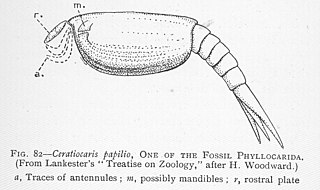
Ceratiocaris is a genus of paleozoic phyllocarid crustaceans whose fossils are found in marine strata from the Upper Ordovician until the genus' extinction during the Silurian. They are typified by eight short thoracic segments, seven longer abdominal somites and an elongated pretelson somite. Their carapace is slightly oval shaped; they have many ridges parallel to the ventral margin and possess a horn at the anterior end. They are well known from the Silurian Eramosa formation of Ontario, Canada.

Paleontology in Iowa refers to paleontological research occurring within or conducted by people from the U.S. state of Iowa. The paleozoic fossil record of Iowa spans from the Cambrian to Mississippian. During the early Paleozoic Iowa was covered by a shallow sea that would later be home to creatures like brachiopods, bryozoans, cephalopods, corals, fishes, and trilobites. Later in the Paleozoic, this sea left the state, but a new one covered Iowa during the early Mesozoic. As this sea began to withdraw a new subtropical coastal plain environment which was home to duck-billed dinosaurs spread across the state. Later this plain was submerged by the rise of the Western Interior Seaway, where plesiosaurs lived. The early Cenozoic is missing from the local rock record, but during the Ice Age evidence indicates that glaciers entered the state, which was home to mammoths and mastodons.
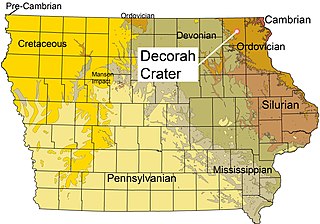
The Decorah crater, also called the Decorah impact structure, is a possible impact crater located on the east side of the city of Decorah in Iowa, United States. It is thought to have been caused by a meteor about 200 metres (660 ft) wide which struck during the Middle Ordovician Period, circa 470 million years ago.

Furca is an extinct genus of marrellomorph arthropod known from the Sandbian stage of the Czech Republic, with a single currently described species, Furca bohemica. A tentative additional species, "Furca mauretanica": was proposed for specimens discovered in Morocco, but this species remains a nomen nudum until formally published, and probably belongs in a new separate genus.

Pentecopterus is a genus of eurypterid, an extinct group of aquatic arthropods. Fossils have been registered from the Darriwilian age of the Middle Ordovician period, as early as 467.3 million years ago. The genus contains only one species, P. decorahensis, that is the oldest known eurypterid, surpassing other Ordovician eurypterids, such as Brachyopterus, in age by almost 9 million years. The generic name derives from the penteconter, a warship from ancient Greece, and the suffix -pterus, which means "wing" and is often used in other genus of eurypterids. The specific name refers to Decorah, Iowa, where Pentecopterus was discovered.
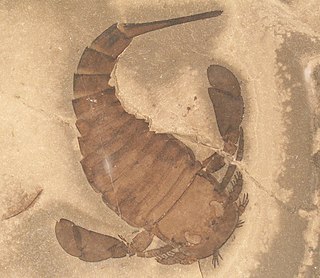
Dekatriata is a clade of planatergan chelicerates including the groups Arachnida, Chasmataspidida, Eurypterida and additionally two stem-genera Winneshiekia and Houia. Dekatriata is defined by an opisthosoma with 13 segments as groundplan and fused, plate-like appendages on the first opisthosomal segment.

Venustulus is a genus of synziphosurine, a paraphyletic group of fossil chelicerate arthropods. Venustulus was regarded as part of the clade Prosomapoda. Fossils of the single and type species, V. waukeshaensis, have been discovered in deposits of the Silurian period in Wisconsin, in the United States. Venustulus is one of the few synziphosurine genera with fossil showing evidence of appendages, the other ones being Weinbergina, Anderella and Camanchia. Despite often being aligned close to horseshoe crabs, it has been found that Venustulus and its relatives form a group made up of various basal euchelicerate arthropods more distant to the xiphosurans.

Camanchia is a genus of synziphosurine, a paraphyletic group of fossil chelicerate arthropods. Camanchia was regarded as part of the clade Prosomapoda. Fossils of the single and type species, C. grovensis, have been discovered in deposits of the Silurian period in Iowa, in the United States. Alongside Venustulus, Camanchia is one of the only Silurian synziphosurine with fossil showing evidence of appendages.

Anderella is a genus of synziphosurine, a paraphyletic group of fossil chelicerate arthropods. Anderella was regarded as part of the clade Prosomapoda. Fossils of the single and type species, A. parva, have been discovered in deposits of the Carboniferous period in Montana, in the United States. Anderella is the first and so far the only Carboniferous synziphosurine being described, making it the youngest member of synziphosurines. Anderella is also one of the few synziphosurine genera with fossil showing evidence of appendages, but the details are obscure due to their poor preservation.

Douglasocaris is a genus of bivalved arthropod from the Middle Ordovician Douglas Lake Member of the Lenoir Limestone from Douglas Dam Tennessee.

The Winneshiek Shale is a Middle Ordovician (Darriwilian-age) geological formation in Iowa. The formation is restricted to the Decorah crater, an impact crater near Decorah, Iowa. Despite only being discovered in 2005, the Winneshiek Shale is already renowned for the exceptional preservation of its fossils. The shale preserves a unique ecosystem, the Winneshiek biota, which is among the most remarkable Ordovician lagerstätten in the United States. Fossils include the oldest known eurypterid, Pentecopterus, as well as giant conodonts such as Iowagnathus and Archeognathus.



















